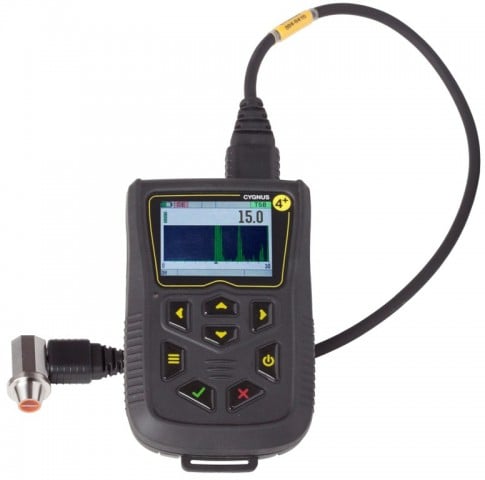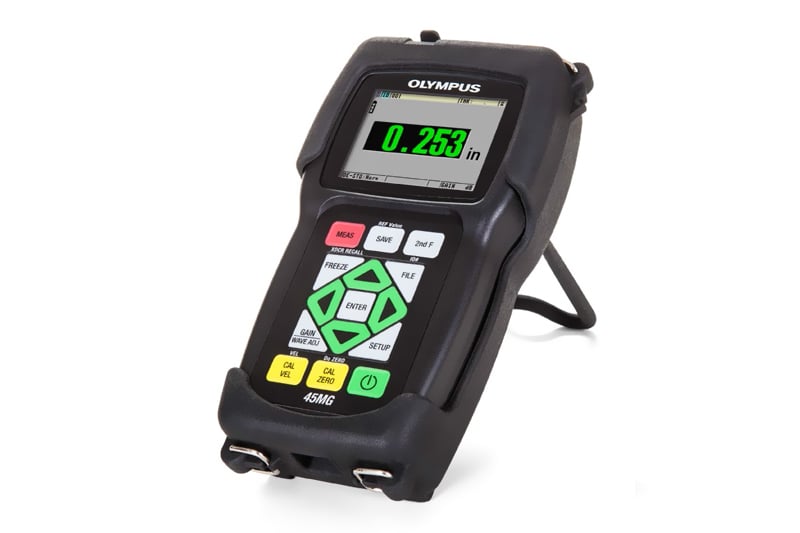How To Use An Ultrasonic Thickness Gauge

Having a basic understanding of how an ultrasonic thickness gauge works is key to using this vital piece of equipment. Ultra-light, rugged models that take advantage of micro components mean calculating the thickness of a wide range of materials can now be carried out quickly and with a high level of accuracy.
Such gauges work by emitting ultrasonic signals that are absorbed and scattered through the material being measured. This data is then analysed to determine the thickness of the material.
- Such a tool can be used on virtually any engineering material, such as plastic, metals, composites, fibreglass and more.
- It’s suitable for measuring individual layers or coatings in multi-layer fabrications.
- The tool is completely non-destructive, and no sectioning or cutting is required.
How the tool works
The tool uses sound waves that travel at frequencies higher than can be detected by human hearing, mostly at levels between 500KHz and 20KHz, although in some cases this extends outside of these parameters.
- The sound is transmitted from an element known as a transducer in a burst of ultrasonic waves.
- This burst travels through the material in a series of organised mechanical vibrations that then reflected back to the receiver – in short, it ‘listens’ for the length of time it takes for this echo to return
- The amount of time this takes can is then used to calculate the thickness of the material.
Considerations for correct usage
It’s essential to correctly calibrate the tool before use and should be carried out as per manufacturer’s instructions. Before any measuring is carried out it’s necessary to carry out various aspects of preparation.
- Select the correct transducer: This will depend on the material being measured, the temperature of the material, physical constraints within the environment (such as a restricted location), temperature of the material and other aspects, including whether the surface is uniform or curved.
- Prepare the surface: The more uneven or rough the surface, the less reliable the readings will be. Clean all debris, rust and scale with a wire brush or, if necessary, grinders and/or sanders.
- The use of couplant: This is a fluid that ensures there’s no gap between the transducer and the material being measured. A small amount should be applied to the surface before a measurement is made – failure to ensure an adequate seal will result in erratic results.
- Orientation of the transducer when measuring tubing and pipes: The diameter of the pipe will determine the amount of measurements necessary and whether to measure in a parallel or perpendicular angle. Larger diameters (greater than 10 cm) should be taken with the transducer held perpendicular to the long axis. For smaller pipes take this measurement and an additional parallel one. The smaller of the measurements is the one that should be recorded.
- Temperature fluctuations: Sound waves move slower through hot material. When performing measurements on surfaces with a high temperature it’s advised to use a transducer specifically designed to work in such conditions and to only keep it in contact for the duration of the measurement to prevent any thermal expansion and resulting accuracy in results.
The measuring procedure
Once all preparations are taken into consideration the actual measuring process is quick and easy.
- Turn the unit on
- Select the correct function for the material to be measured
- Add a small amount of couplant to the surface
- Place the probe onto the gel-covered surface
- Record the reading
Ultrasonic thickness gauges are vital tools that can assist with safely extending the longevity of a variety of structures. Their role in effective maintenance within industries such as the petrochemical, oil and gas, manufacturing and energy is essential. Solution-focused equipment provider, Nexxis, offers a wide variety of cutting-edge testing equipment, with a variety of options to suit all needs and overcome the most complex of challenges.
Applying a dynamic strategy that focuses on evolving customer needs is just one of the reasons our worldwide company has become the premier supplier of technical equipment to global industry. To discover more about how this innovative approach can save your business time and money visit contact your closest office in Australia, Singapore or USA now.

